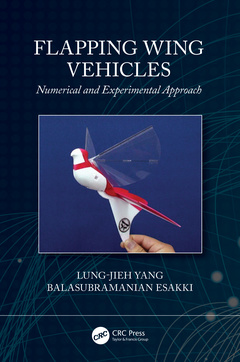Description
Flapping Wing Vehicles
Numerical and Experimental Approach
Authors: Yang Lung-Jieh, Esakki Balasubramanian
Language: English
Subjects for Flapping Wing Vehicles:
Keywords
Net Thrust; Flapping Frequency; Micro air vehicle (MAV); Flapping Wing; Unmanned air vehicle (UAV); Inclined Angles; Ornithopters; Flapping Mechanism; Soap Film Flow; Power Consumption; Wing Rotation; BLDC; Servo; Stroke Angle; Wind Tunnel Experiments; Mem Sensor; BLDC Motor; Lift Coefficient; Gear Ratio; Wind Tunnel; Pid Controller; Stroke Reversal; Mem Process; Flapping Motion; Lift Force; Wind Speed; PVDF Piezoelectric Film; Bevel Gear; Maximum Thrust Force; Cfd Analysis
77.28 €
In Print (Delivery period: 14 days).
Add to cartPublication date: 09-2023
· 15.6x23.4 cm · Paperback
202.60 €
In Print (Delivery period: 14 days).
Add to cartPublication date: 09-2021
· 15.6x23.4 cm · Hardback
Description
/li>Contents
/li>Biography
/li>
Flapping wing vehicles (FWVs) have unique flight characteristics and the successful flight of such a vehicle depends upon efficient design of the flapping mechanisms while keeping the minimum weight of the structure. Flapping Wing Vehicles: Numerical and Experimental Approach discusses design and kinematic analysis of various flapping wing mechanisms, measurement of flap angle/flapping frequency, and computational fluid dynamic analysis of motion characteristics including manufacturing techniques. The book also includes wind tunnel experiments, high-speed photographic analysis of aerodynamic performance, soap film visualization of 3D down washing, studies on the effect of wing rotation, figure-of-eight motion characteristics, and more.
Features
- Covers all aspects of FWVs needed to design one and understand how and why it flies
- Explains related engineering practices including flapping mechanism design, kinematic analysis, materials, manufacturing, and aerodynamic performance measures using wind tunnel experiments
- Includes CFD analysis of 3D wing profile, formation flight of FWVs, and soap film visualization of flapping wings
- Discusses dynamics and image-based control of a group of ornithopters
- Explores indigenous PCB design for achieving altitude and attitude control
This book is aimed at researchers and graduate students in mechatronics, materials, aerodynamics, robotics, biomimetics, vehicle design and MAV/UAV.
Prof. Lung-Jieh Yang received Ph.D. from Institute of Applied Mechanics, National Taiwan University in 1997 and has one-year sabbatical leave to Caltech for learning MEMS technology during 2000-2001. He is now a full professor and the former department chair of Mechanical Engineering, Tamkang University, and is also the editor-in-chief of "Journal of Applied Science and Engineering" (an EI/Scopus/ESCI journal with ISSN 1560-6686). Prof. Yang devoted to the researches of polymer microelectromechanical systems (polymer MEMS, especially parylene and gelatin techniques) and flapping wing micro air vehicles (FWMAVs) for 20 years and has ever published 66 journal papers, more than 100 conference papers, 2 textbooks about MEMS, and 17 US/Taiwan patents about polymer MEMS and micro ornithopters. He has ever been the Taiwan side’s PI of the Indo-Taiwan project "Design, Development and Formation Control of Micro Ornithopters (102-2923-E-032-001-MY3)" during 2013-2016. In this project he built up not only the technical cooperation between India and Taiwan but also coauthors several international journal papers with some Indian scholars/institutes. Prof. Yang hosted 2 international conferences including "The International Conference on Biomimetic and Ornithopters (ICBAO-2015)" and "The International Conference on Intelligent Unmanned Systems (ICIUS-2017)." He is also one of the vice presidents of International Society of Intelligent Unmanned Systems (ISIUS) since 2017.
Dr Esakki Balasubramanian received PhD in the field of Robotics and Control at Concordia University, Montreal, Canada. He has published two books, more than 100 Journals and Conference papers and 7 patents have been applied. He received grants from various Government of India funding programmes supported through DST, DRDO, ISRO, DBT. He has collaborated with Taiwan scientists under Indo-Taiwan schema (2013-16) for the development of micro aerial flapping wing vehicles and formation control throug




